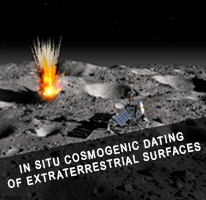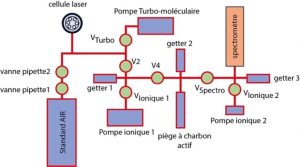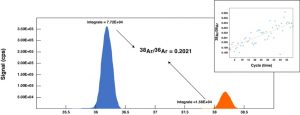V3: In situ cosmogenic dating of extraterrestrial surfaces
> Read the articles connected to the project.
.
-

Our project is the design of a prototype of “spatializable” mass spectrometer and its preparation line dedicated to the analysis of all noble gases, in order to estimate, by in situ measure-ments, exposure ages of extraterrestrial samples (Mars, The Moon and asteroids). It is clear that only a small number (and mass) of samples will be returned to Earth, and therefore the careful choice of these samples, and the in situ analyses of a large number of samples will stay the better technic to answer to some simple but important scientific questions such as age surfaces, ages and frequency of impacts, or exposure duration by the solar wind.
-
Design and tests
POSITION NAME SURNAME LABORATORY NAME GRADE, EMPLOYER WP leader Moreira Manuel CAGE PR, Paris Diderot WP member Moureau Julien CAGE IE Collaborators for the stage 2 of the project t (>2020):
- S.Charnoz
- F. Moynier
- J. Badro
- M. Chaussidon
-
A) Installation of the mass spectrometer and its preparation line

Figure 1: Schematic of the measurement line of cosmogenic noble gases in extraterrestrial samples, mounted in early 2018, and which is currently producing data on meteorites.
At the beginning of the year 2018, we have received, installed and mounted the Pfeiffer quadrupole mass spectrometer1 and its line acquired thanks to the funds from the Labex. The schematic of the gas extraction and purification line that we have constructed is given Figure 1. This line has been designed in a way that corresponds to the following criteria:
• The smallest and lightest possible with the vacuum technology necessary for noble gas analysis
• Fully automated
• It allows a duration of the experiment that is shorter than 1h30, including the measurements of noble gas isotopes
• Purification of reactive gases should be complete
• Separation of He+Ne from Ar+Kr is required to avoid isobaric interferencesThe line is therefore composed of three main parts: extraction, purification, and separation parts of the rare gases between them. Gas extraction is performed thanks to a Y-doped fiber laser, allowing step heating of samples with masses of ~5-10mg. A SAES CAPACITOR D100 getter, that can be heated at 400 °C (24W) during experiments, allows the purification of all gases except noble gases. The heavy noble gases are trapped on activated carbon at the temperature of liquid nitrogen (77K). A turbo-molecular pump and an ion pump maintain a high vacuum in the line. An ion pump equips the mass spectrometer itself. We have chosen a pump model particularly suitable for space sciences because it is a PID3 pump (Vinci technologies) having a low mass (0.85kg, 3L / s) and whose electronics are also very light. To determine sensitivity and mass discrimination, we use an air standard (pipette volume of 1.92cc connected to a 5-liters reservoir). We adjusted the pressure of the standard to obtain 2.2 10-5 cc of air by standard shot. Two SAES getters are also connected to the line and to the mass spectrometer, but they are used at room temperature to trap residual hydrogen. Volumes in the line are separated by Swagelok SS-4BW-V51-3C valves activated with compressed air. We have also conceived and constructed an electronic device to pilot these valves using a Festo© air distributor commanded by a 24 I/O card (Easydaq).
During the spring 2018, we have performed the first tests on standards and on extraterrestrial samples (chondrites/ Moon), with the help of a L3 student (Nadir Guendouz), to better apprehend the quality and performance of the instrument. These results were of high quality for neon and argon isotopic ratios – on the same level as magnetic sector mass spectrometers- but we had at that time some issues concerning the presence of hydrocarbons in the line and in the mass spectrometer, which produced anomalous Kr isotopic ratios. This contamination issue was solved with a baking of the instrument at 250°C for two weeks.
During that period, we have written and regularly improved the softwares used for piloting the line, the data acquisition, and the data processing. We have chosen Python© to avoid commercial software and to be able to produce an open-source software.
B) Tests and best strategy for data analysis

Figure 2: Example of a scan on the electron multiplier (equipped in pulse counting) between masses 35 and 39. We then estimate for each cycle the areas under the peaks to obtain the isotopic ratios. We then extrapolate all these isotopic ratios to the introduction time of the gas into the mass spectrometer. This is done for all isotopic ratios (20Ne/22Ne, 21Ne/22Ne, 38Ar/36Ar, 40Ar/36Ar, and iKr/84Kr). This example was obtained on the Allende CV3 chondrite.
During that phase of tests and software writing (January-June 2018), we also defined our strategy for data processing obtained with the quadrupole mass spectrometer and test the best method. On typical magnetic sector instruments, for each mass, the signals are integrated on the flat peaks for a given period of time. However, on such quadrupole instruments the peaks are not flat (Figure 2). Therefore, we have considered calculating the areas under the peaks to estimate both the concentrations and the isotopic ratios of the 4 noble gases (He, Ne, Ar, Kr since our instrument does not allow xenon analysis). Moreover, this mass-scan procedure is fast enough that it allows the measurements of more than 100 cycles in a relatively short time, allowing a good accuracy on the mean or on the extrapolated isotopic ratios at time 02. This procedure is applied for blanks, standards and samples.
We have to admit that the quality of the results is clearly better than expected, for all noble gases. The instrument is extremely stable and reproducible for both abundances and isotopic ratios 3 . It has to be noticed that such reproducibility is better – for similar quantities of gas – than the one obtained of the mass spectrometer HELIX SFT we have acquired a few years ago.
C) A pilot study on the krypton analysis of carbonaceous chondrites
After this period of construction and tests of the new instrument, and after having considered that the accuracy is remarkably good and sufficient, we have started in September 2018 a study on the noble gas composition of carbonaceous chondrites. Our objective is to analyze a large number of chondrites to better determine the so-called “AVCC”-Kr (average carbonaceous chondrites), which is poorly defined because of the very small number of samples that were analyzed in bulk for krypton isotopes (~10 samples) [Pepin, 2003]. The definition of this component is crucial to determine the origin of heavy noble gases on Earth and the amount of recycled atmospheric noble gases into the mantle [Holland et al., 2009]. Because our new technique allows fast measurements (sample in less than 2h), it is possible to produce the isotopic ratios of the noble gases in a large number of samples. Using a laser (ytterbium fiber laser), we can do bulk measurements of ~mg-size meteorites and therefore better define the “AVCC” composition for krypton. This project is on-going and will be continued during the next 6 months.
-
Roubinet, C., M. Moreira (2018),
Atmospheric noble gases in Mid-Ocean Ridge Basalts: Identification of atmospheric contamination processes,
Geochimica Cosmochimica Acta, 222, 253-268.Péron, S., M. Moreira and A. Agranier (2018),
Origin of Light Noble Gases (He, Ne, Ar) on Earth,
a Review, Geochemistry, Geophysics, Geosystems, 19. https://doi.org/10.1002/2017GC007388Péron S. and M. Moreira, October 2018
Onset of volatile recycling into the mantle determined by xenon anomalies
accepted at Geochemical Perspective lettersChavrit D., M. Moreira, D. Fike and F. Moynier, October 2018
Unusual neon isotopic composition in Neoproterozoïc sedimentary rocks: fluorine bearing mineral contribution or trace of an impact event?
accepted at Chemical Geology
